Use of Computational Fluid Dynamics to Study Ammonia Concentrations at Pedestrian Height in Smart Broiler Chamber Clusters
Abstract
1. Introduction
2. Experiments and Methods
2.1. Research Objects
2.2. Experimental Scheme
2.2.1. Scenarios
2.2.2. Random Sampling Points
2.3. CFD Simulation
2.3.1. Control Equations
2.3.2. Mesh
2.3.3. Boundary Conditions
2.3.4. Solver Parameters and Settings
2.4. Power Law Wind Profile Model
2.5. Statistics
3. Results
3.1. Ammonia Mole Fraction Distribution 1.5 m above the Ground
3.2. Random Sampling of Ammonia Concentration at 1.5 m above the Ground
4. Discussion
5. Conclusions
Author Contributions
Funding
Institutional Review Board Statement
Data Availability Statement
Acknowledgments
Conflicts of Interest
References
- Shi, Q.; Wang, W.; Chen, M.; Zhang, H.; Xu, S. Ammonia induces Treg/Th1 imbalance with triggered NF-κB pathway leading to chicken respiratory inflammation response. Sci. Total Environ. 2019, 659, 354–362. [Google Scholar] [CrossRef]
- Sundblad, B.-M.; Larsson, B.-M.; Acevedo, F.; Ernstgård, L.; Johanson, G.; Larsson, K.; Palmberg, L. Acute respiratory effects of exposure to ammonia on healthy subjects. Scand. J. Work. Environ. Health 2004, 30, 313–321. [Google Scholar] [CrossRef] [PubMed]
- Wyer, K.E.; Kelleghan, D.B.; Blanes-Vidal, V.; Schauberger, G.; Curran, T.P. Ammonia emissions from agriculture and their contribution to fine particulate matter: A review of implications for human health. J. Environ. Manag. 2022, 323, 116285. [Google Scholar] [CrossRef] [PubMed]
- Ryer-Powder, J.E. Health effects of ammonia. Plant Oper. Prog. 1991, 10, 228–232. [Google Scholar] [CrossRef]
- Stokstad, E. Ammonia Pollution From Farming May Exact Hefty Health Costs. Science 2014, 343, 238. [Google Scholar] [CrossRef] [PubMed]
- Spencer, J.; Van Heyst, B. A review of particulate matter emissions and impacts on human health: A focus on Canadian agricultural and rural emission sources. Can. Biosyst. Eng. Le Génie Des Biosystèmes Au Can. 2018, 60, 6–9. [Google Scholar] [CrossRef]
- National Research Council (US) Committee on Acute Exposure Guideline Levels. Ammonia Acute Exposure Guideline Levels. Available online: https://www.ncbi.nlm.nih.gov/books/NBK207883/ (accessed on 10 December 2022).
- Health and Safety Authority. Health and Safety Authority Draft 2018 Code of Practice for the Chemical Agents Regulations. Available online: https://chemistry.tcd.ie/assets/pdf/Safety/Chemical_Agents_COP_2018.pdf (accessed on 20 December 2022).
- CDC. NIOSH Pocket Guide to Chemical Hazards-Ammonia. Available online: https://www.cdc.gov/niosh/npg/npgd0028.html (accessed on 15 December 2022).
- Ministry of Health of the People’s Republic of China. Hygienic Standards for the Design of Industrial Enterprises (TJ36-79); People’s Medical Publishing House Co., Ltd.: Beijing, China, 1979.
- Zou, X.; Wang, S.; Qian, Y.; Gong, F.; Zhang, S.; Hu, J.; Liu, W.; Song, Y.; Zhang, S.; Meng, J.; et al. Study of Ammonia Concentration Characteristics and Optimization in Broiler Chamber during Winter Based on Computational Fluid Dynamics. Agriculture 2022, 12, 182. [Google Scholar] [CrossRef]
- Behera, S.N.; Sharma, M.; Aneja, V.P.; Balasubramanian, R. Ammonia in the atmosphere: A review on emission sources, atmospheric chemistry and deposition on terrestrial bodies. Environ. Sci. Pollut. Res. 2013, 20, 8092–8131. [Google Scholar] [CrossRef]
- Sutton, M.A.; Erisman, J.W.; Dentener, F.; Möller, D. Ammonia in the environment: From ancient times to the present. Environ. Pollut. 2008, 156, 583–604. [Google Scholar] [CrossRef]
- Yao, H.; Sun, Q.; Zou, X.; Wang, S.; Zhang, S.; Zhang, S.; Zhang, S. Research of yellow-feather chicken breeding model based on small chicken chamber. INMATEH-Agric. Eng. 2018, 56, 91–100. [Google Scholar]
- Zhang, S.; Ding, A.; Zou, X.; Feng, B.; Qiu, X.; Wang, S.; Zhang, S.; Qian, Y.; Yao, H.; Wei, Y. Simulation Analysis of a Ventilation System in a Smart Broiler Chamber Based on Computational Fluid Dynamics. Atmosphere 2019, 10, 315. [Google Scholar] [CrossRef]
- Naseem, S.; King, A.J. Ammonia production in poultry houses can affect health of humans, birds, and the environment—Techniques for its reduction during poultry production. Environ. Sci. Pollut. Res. 2018, 25, 15269–15293. [Google Scholar] [CrossRef]
- Sapounas, A.; Campen, J.; Smits, M.; Van Dooren, H. Simulating the effect of forced pit ventilation on ammonia emission from a naturally ventilated cow house with CFD. In Proceedings of the 4th European Conference on Precision Livestock Farming, Wageningen, The Netherlands, 6–8 July 2009; pp. 81–89. [Google Scholar]
- Alexander Osorio, J.; Sullivan Rocha, K.; De Fatima Ferreira Tinôco, I.; S Gates, R.; Lucia Zapata, O.; Barreto Mendes, L.; Alves Damasceno, F. Use of CFD Modeling for Determination of Ammonia Emission in Non-Insulated Poultry Houses with Natural Ventilation; American Society of Agricultural and Biological Engineers: St. Joseph, MI, USA, 2011. [Google Scholar]
- Osorio Saraz, J.A.; Ferreira Tinôco, I.d.F.; Olivera Rocha, K.S.; Barreto Mendes, L.; Norton, T. A CFD based approach for determination of ammonia concentration profile and flux from poultry houses with natural ventilation. Rev. Fac. Nac. De Agron. 2016, 69, 7825–7834. [Google Scholar] [CrossRef]
- Tabase, R.K.; Van Linden, V.; Bagci, O.; De Paepe, M.; Aarnink, A.J.A.; Demeyer, P. CFD simulation of airflows and ammonia emissions in a pig compartment with underfloor air distribution system: Model validation at different ventilation rates. Comput. Electron. Agric. 2020, 171, 105297. [Google Scholar] [CrossRef]
- Cheng, Q.; Feng, H.; Meng, H.; Zhou, H. CFD study of the effect of inlet position and flap on the airflow and temperature in a laying hen house in summer. Biosyst. Eng. 2021, 203, 109–123. [Google Scholar] [CrossRef]
- Wang, X.; Li, J.; Wu, J.; Yi, Q.; Wang, X.; Wang, K. Numerical Simulation of the Placement of Exhaust Fans in a Tunnel-Ventilated Layer House During the Fall. Trans. ASABE 2021, 64, 1955–1966. [Google Scholar] [CrossRef]
- Babadi, K.A.; Khorasanizadeh, H.; Aghaei, A. CFD modeling of air flow, humidity, CO2 and NH3 distributions in a caged laying hen house with tunnel ventilation system. Comput. Electron. Agric. 2022, 193, 106677. [Google Scholar] [CrossRef]
- Yang, Z.; Tu, Y.; Ma, H.; Yang, X.; Liang, C. Numerical simulation of a novel double-duct ventilation system in poultry buildings under the winter condition. Build. Environ. 2022, 207, 108557. [Google Scholar] [CrossRef]
- Lin, C.; Wang, Y.; Ooka, R.; Flageul, C.; Kim, Y.; Kikumoto, H.; Wang, Z.; Sartelet, K. Modeling of street-scale pollutant dispersion by coupled simulation of chemical reaction, aerosol dynamics, and CFD. Atmos. Chem. Phys. 2023, 23, 1421–1436. [Google Scholar] [CrossRef]
- Sun, C.; Zhang, F.; Zhao, P.; Zhao, X.; Huang, Y.; Lu, X. Automated Simulation Framework for Urban Wind Environments Based on Aerial Point Clouds and Deep Learning. Remote Sens. 2021, 13, 2383. [Google Scholar] [CrossRef]
- Li, J.; Zheng, B.; Ouyang, X.; Chen, X.; Bedra, K.B. Does shrub benefit the thermal comfort at pedestrian height in Singapore? Sustain. Cities Soc. 2021, 75, 103333. [Google Scholar] [CrossRef]
- Yang, J.; Shi, B.; Xia, G.; Xue, Q.; Cao, S.-J. Impacts of Urban Form on Thermal Environment Near the Surface Region at Pedestrian Height: A Case Study Based on High-Density Built-Up Areas of Nanjing City in China. Sustainability 2020, 12, 1737. [Google Scholar] [CrossRef]
- Versteeg, H.K.; Malalasekera, W. An Introduction to Computational Fluid Dynamics: The Finite Volume Method; Pearson Education: London, UK, 2007. [Google Scholar]
- Davenport, A.G. Rationale for Determining Design Wind Velocities; National Research Council of Canada Ottawa (Ontario) Div of Building Research: Ottawa, ON, Canada, 1960.
- GB50009-2012; Load Code for the Design of Building Structures; China Association for Engineering Construction Standardization (CECS). China Architecture & Building Press: Beijing, China, 2012.
- Konkol, D.; Popiela, E.; Skrzypczak, D.; Izydorczyk, G.; Mikula, K.; Moustakas, K.; Opaliński, S.; Korczyński, M.; Witek-Krowiak, A.; Chojnacka, K. Recent innovations in various methods of harmful gases conversion and its mechanism in poultry farms. Environ. Res. 2022, 214, 113825. [Google Scholar] [CrossRef] [PubMed]
- Brautbar, N.; Wu, M.P.; Richter, E.D. Chronic Ammonia Inhalation and Interstitial Pulmonary Fibrosis: A Case Report and Review of the Literature. Arch. Environ. Health Int. J. 2003, 58, 592–596. [Google Scholar] [CrossRef]
- Rahman, M.D.H.; Bråtveit, M.; Moen, B.E. Exposure to Ammonia and Acute Respiratory Effects in a Urea Fertilizer Factory. Int. J. Occup. Environ. Health 2007, 13, 153–159. [Google Scholar] [CrossRef] [PubMed]
- Such, N.; Mezőlaki, Á.; Rawash, M.A.; Tewelde, K.G.; Pál, L.; Wágner, L.; Schermann, K.; Poór, J.; Dublecz, K. Diet Composition and Using Probiotics or Symbiotics Can Modify the Urinary and Faecal Nitrogen Ratio of Broiler Chicken’s Excreta and Also the Dynamics of In Vitro Ammonia Emission. Animals 2023, 13, 332. [Google Scholar]
- Tang, C.; Kong, W.; Wang, H.; Liu, H.; Shi, L.; Uyanga, V.A.; Zhao, J.; Wang, X.; Lin, H.; Jiao, H. Effects of fulvic acids on gut barrier, microbial composition, fecal ammonia emission, and growth performance in broiler chickens. J. Appl. Poult. Res. 2023, 32, 100322. [Google Scholar] [CrossRef]
- Fenske, K.; Lemme, A.; Rother, E.; Westendarp, H. Scaling Up the Effects of Low Nitrogen in Commercial Broiler Farms. Agriculture 2023, 13, 33. [Google Scholar] [CrossRef]
- Brink, M. Source-Oriented Strategies to Mitigate Ammonia Emission from Broiler Production; Ghent University: Merelbeke, Belgium, 2022. [Google Scholar]
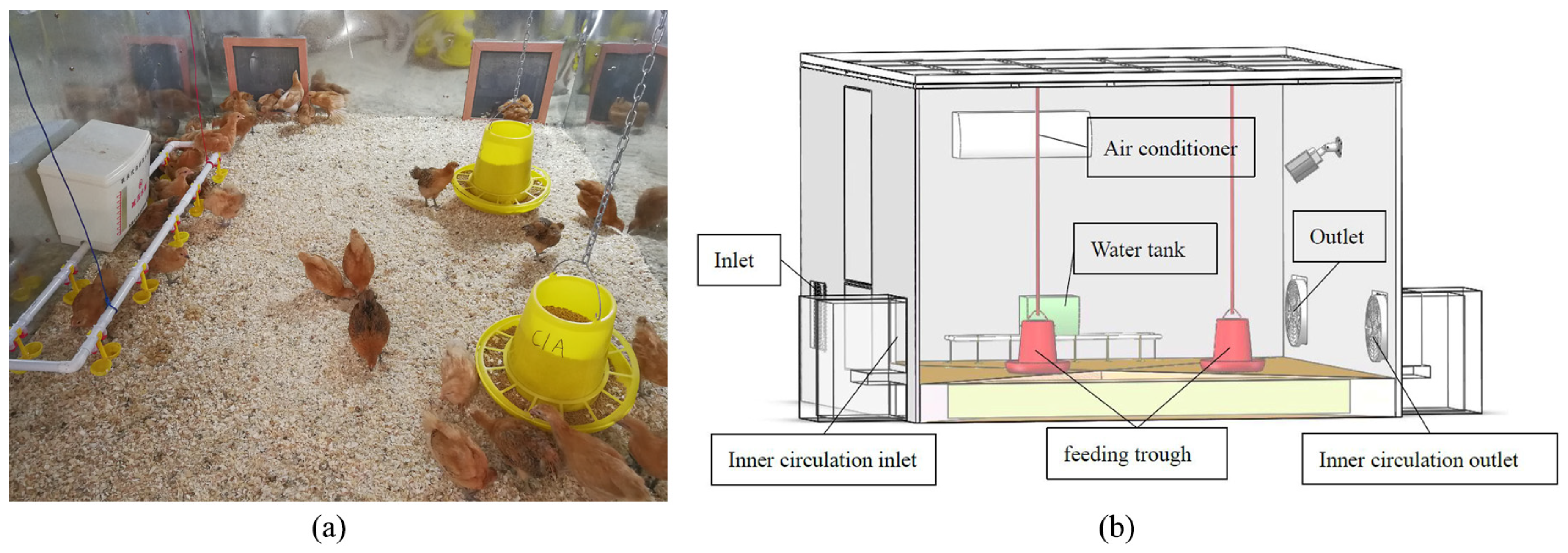
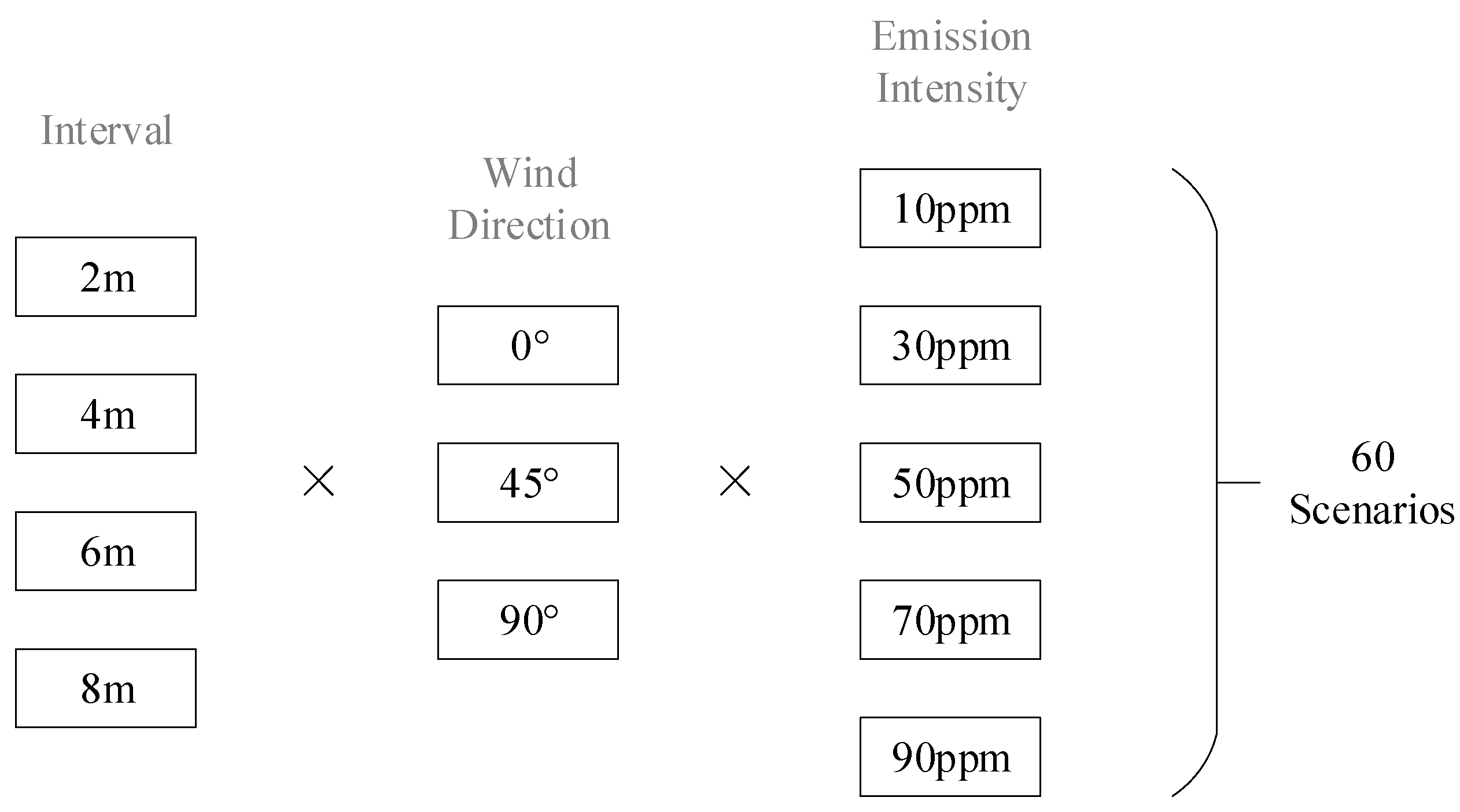
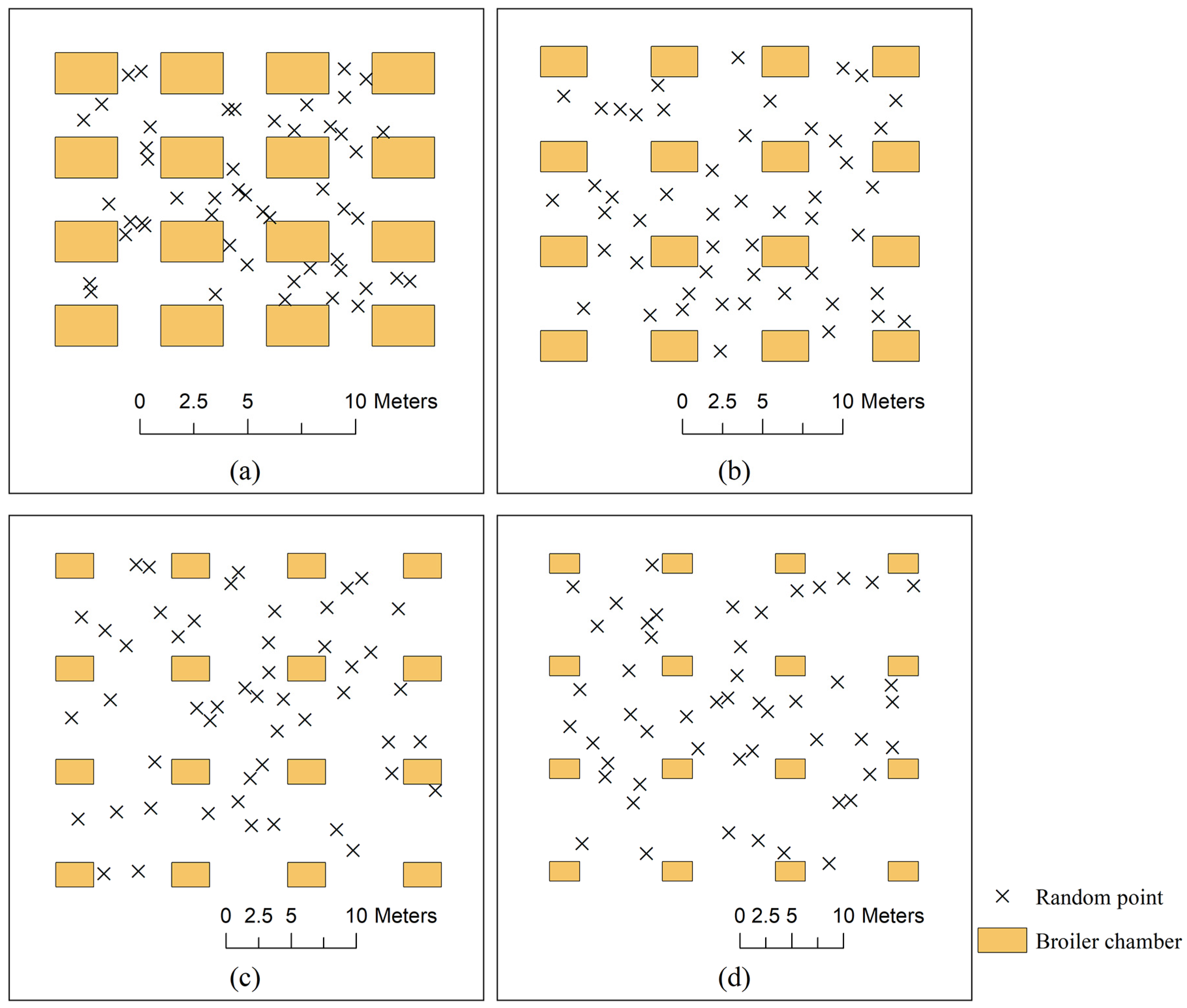
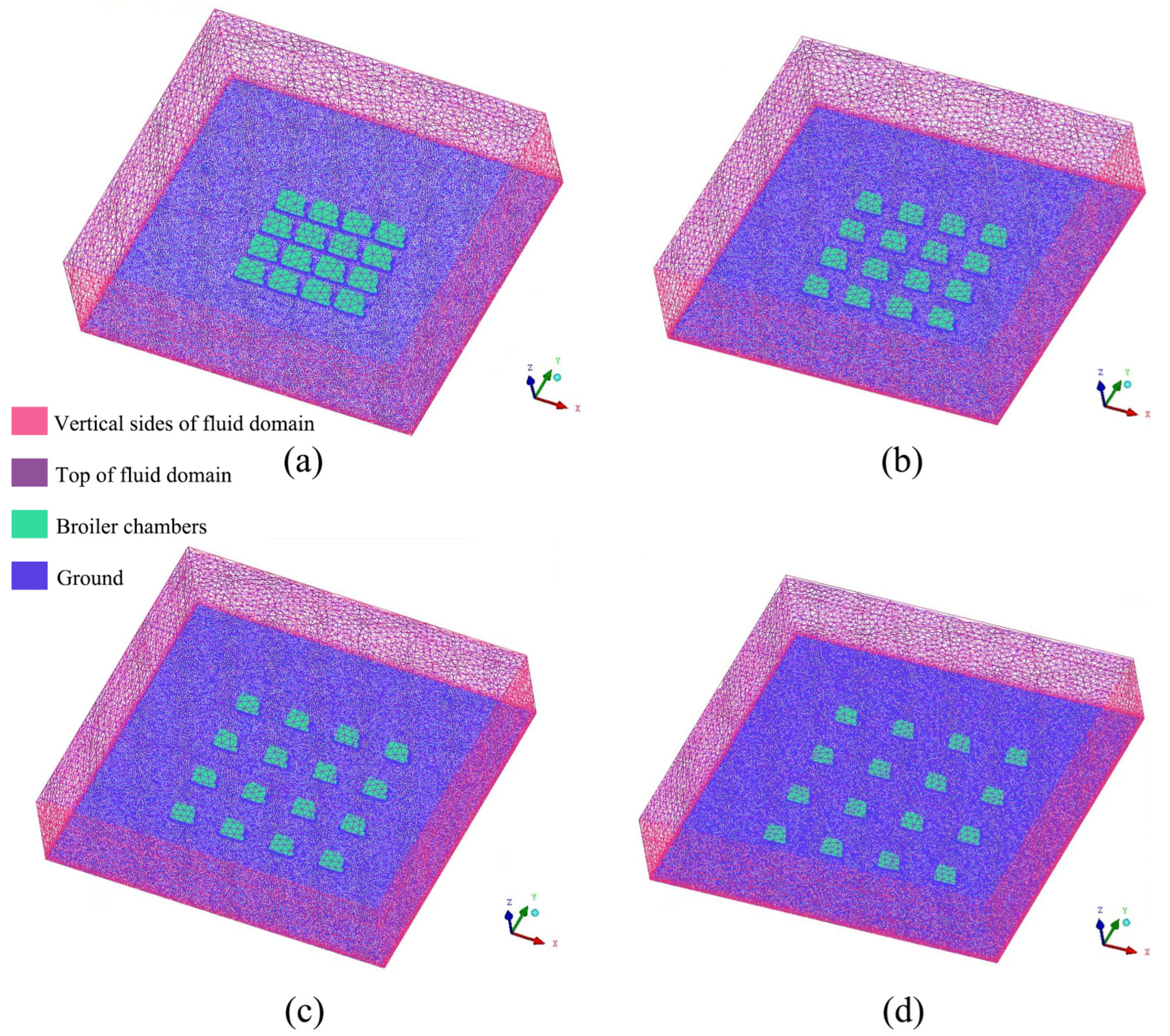
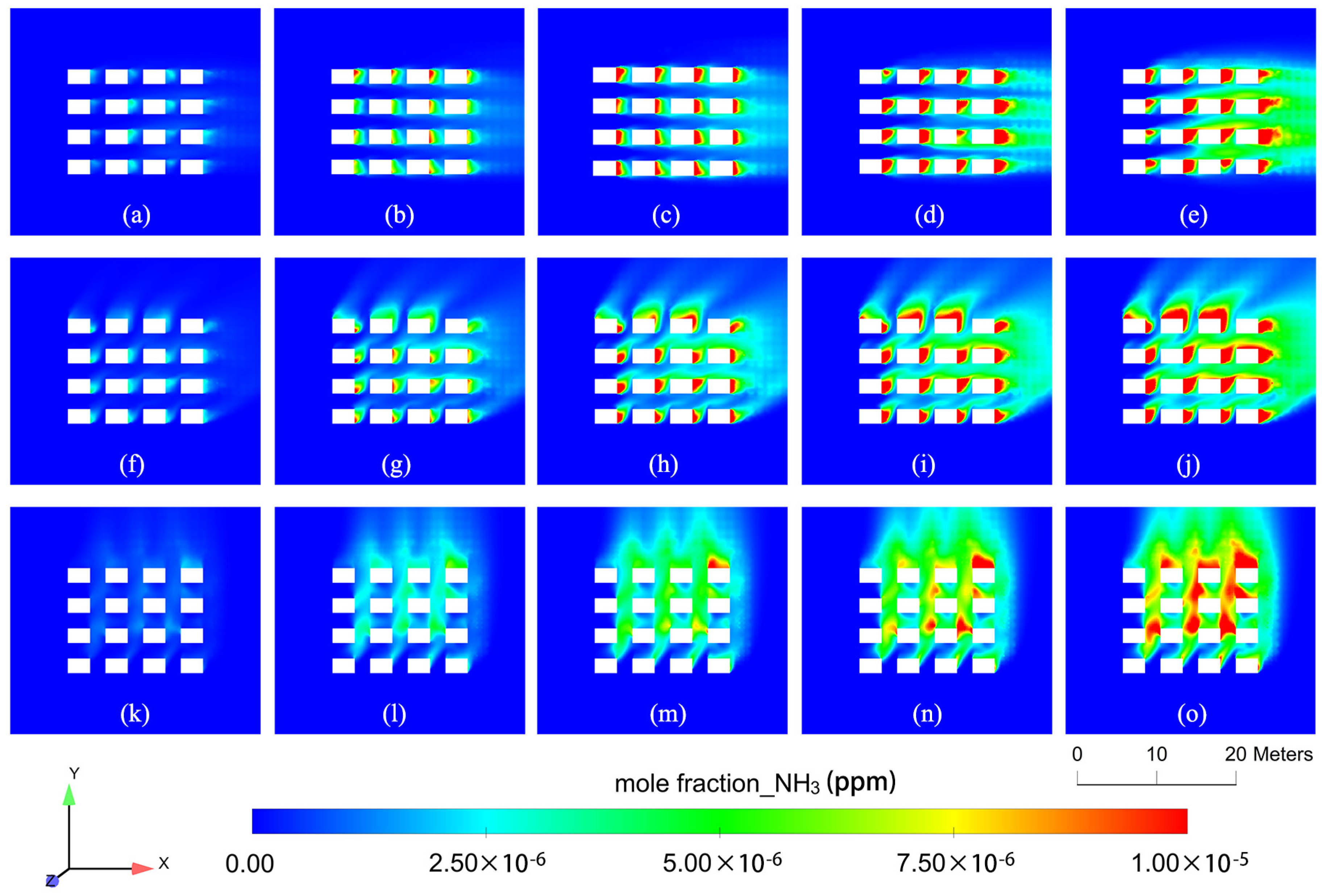
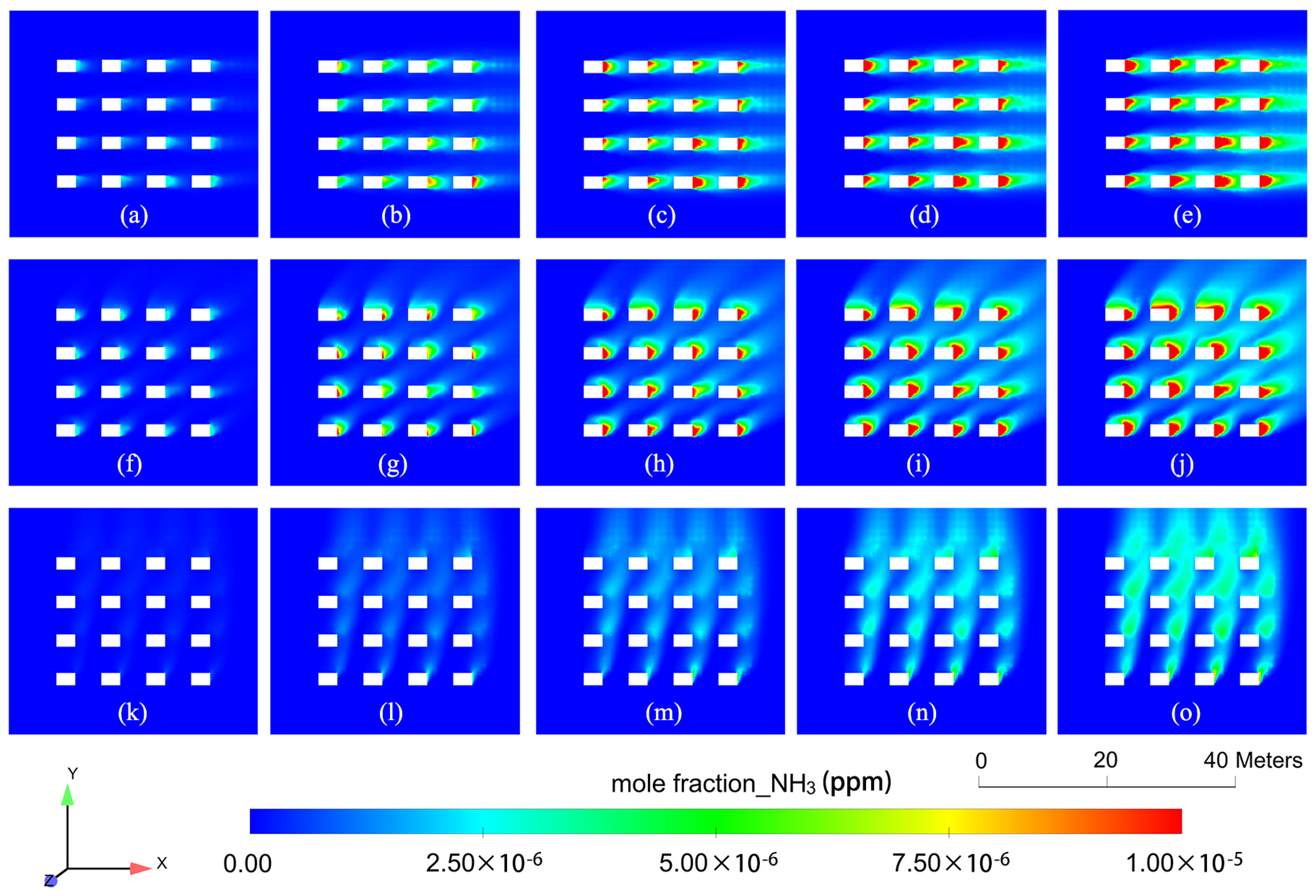
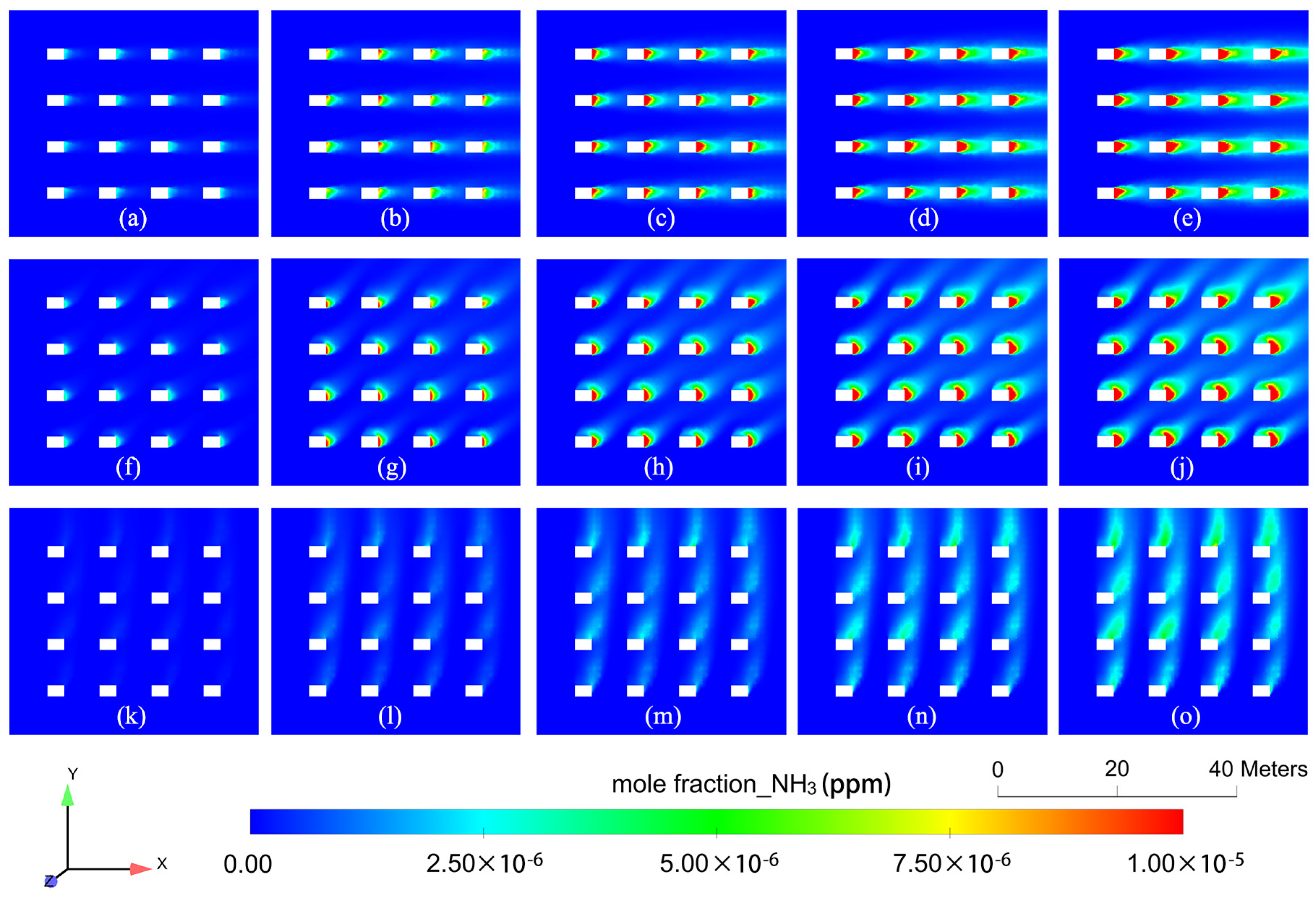
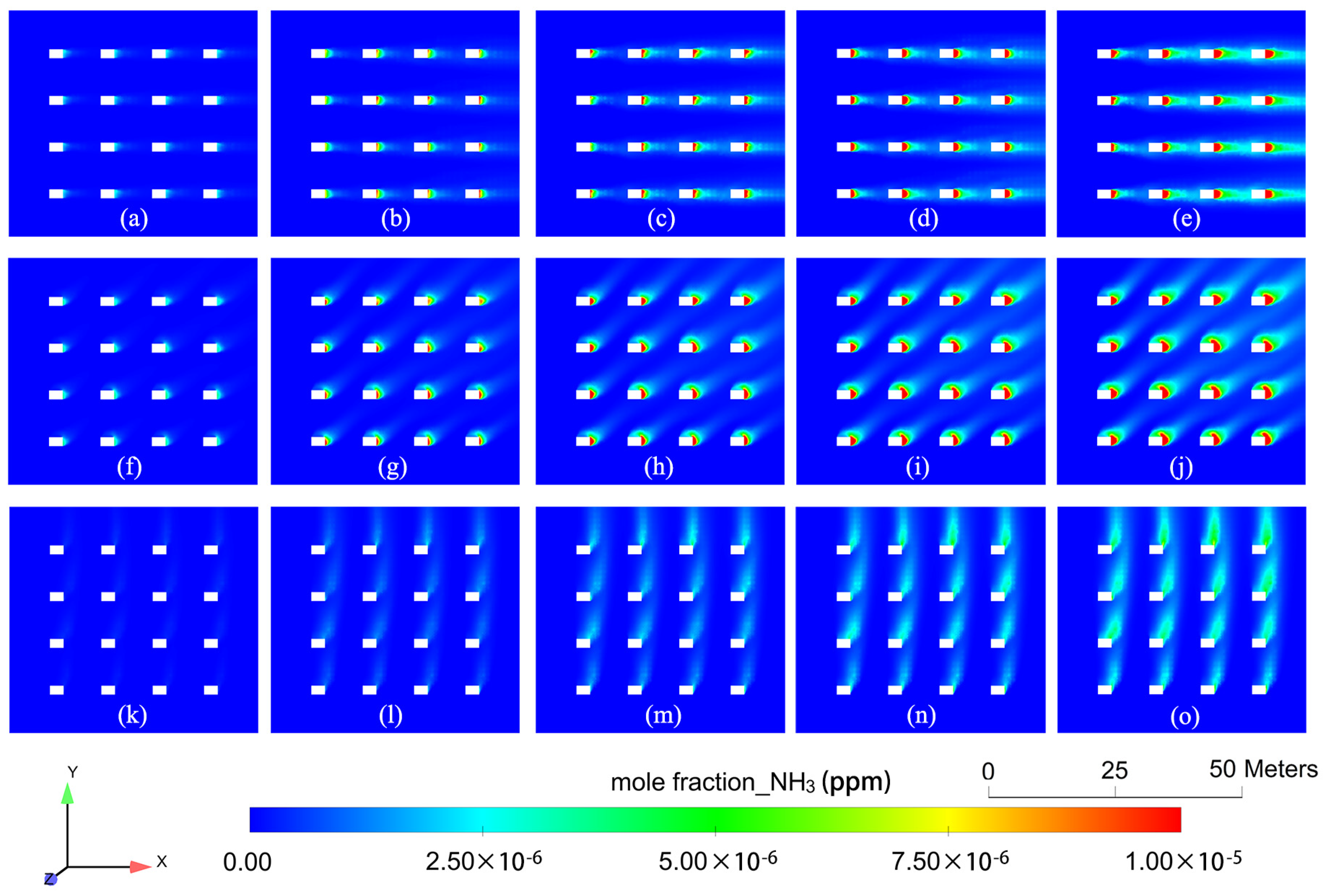
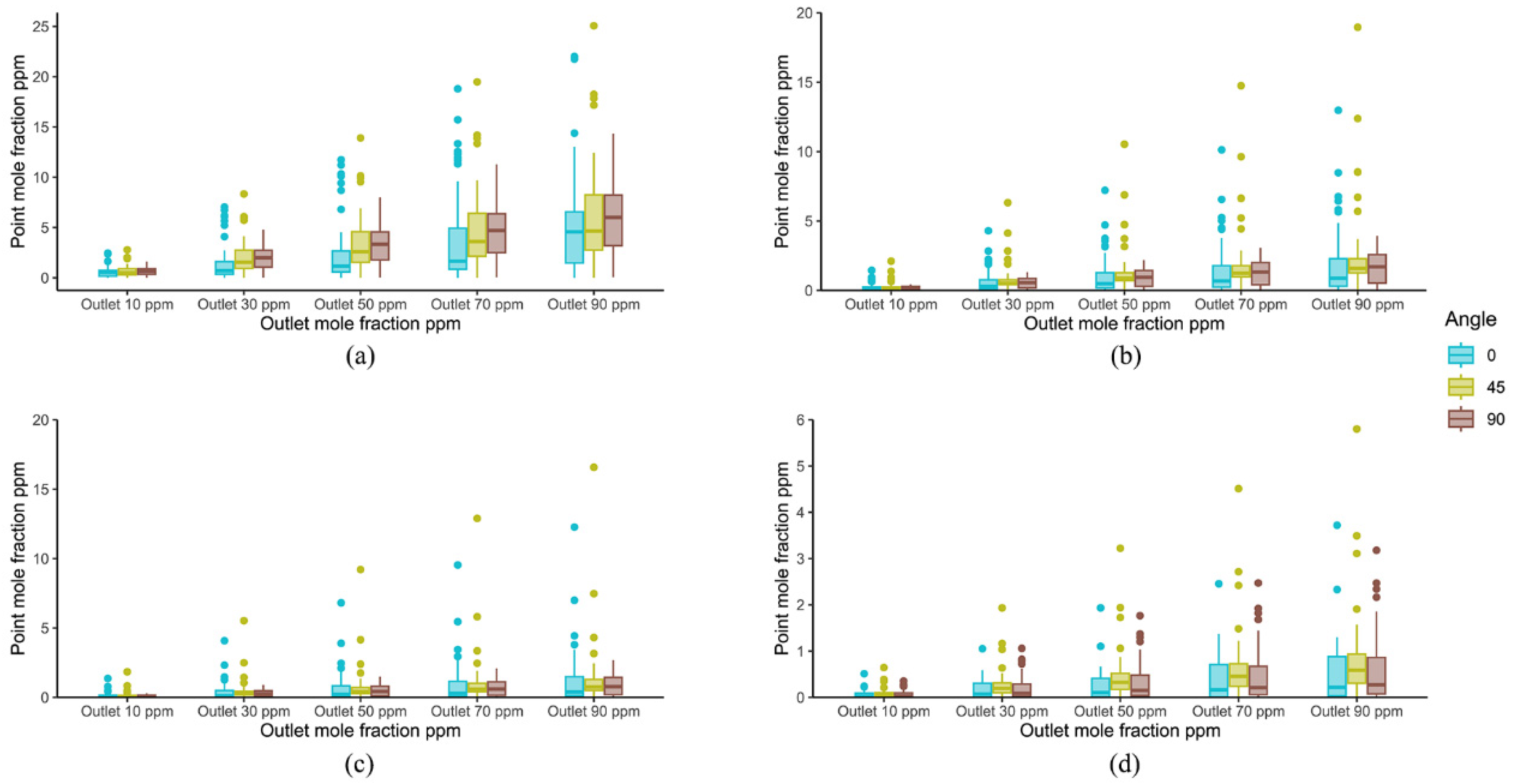
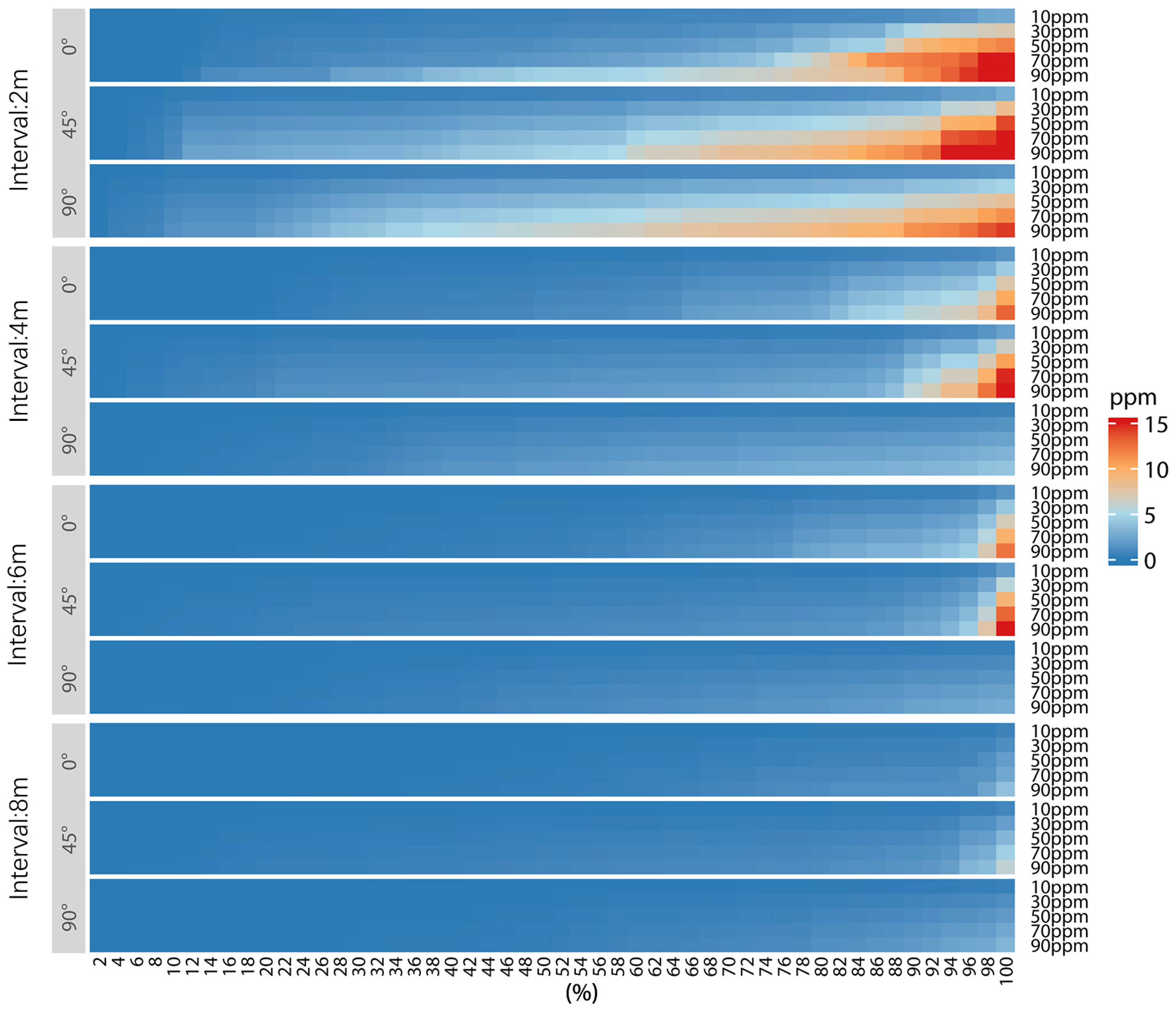
| Zone | Maximum Mesh Size |
|---|---|
| Chamber outlets | 0.02 m |
| Chamber inlets | 0.02 m |
| Wall of the broiler chambers | 0.1 m |
| Ground | 0.5 m |
| Vertical sides of the fluid domain | 2 m |
| Top of the fluid domain | 2 m |
| Interior of the fluid domain | 2 m |
| Zone | Type |
|---|---|
| Chamber outlets | Mass flow inlet |
| Chamber inlets | Pressure outlet |
| Wall of the broiler chambers | Wall |
| Ground | Wall |
| Inflow boundaries of the fluid domain | Velocity inlet |
| Outflow boundaries of the fluid domain | Pressure outlet |
| Top of the fluid domain | Symmetry |
Disclaimer/Publisher’s Note: The statements, opinions and data contained in all publications are solely those of the individual author(s) and contributor(s) and not of MDPI and/or the editor(s). MDPI and/or the editor(s) disclaim responsibility for any injury to people or property resulting from any ideas, methods, instructions or products referred to in the content. |
© 2023 by the authors. Licensee MDPI, Basel, Switzerland. This article is an open access article distributed under the terms and conditions of the Creative Commons Attribution (CC BY) license (https://creativecommons.org/licenses/by/4.0/).
Share and Cite
Li, M.; Zou, X.; Feng, B.; Qiu, X. Use of Computational Fluid Dynamics to Study Ammonia Concentrations at Pedestrian Height in Smart Broiler Chamber Clusters. Agriculture 2023, 13, 656. https://doi.org/10.3390/agriculture13030656
Li M, Zou X, Feng B, Qiu X. Use of Computational Fluid Dynamics to Study Ammonia Concentrations at Pedestrian Height in Smart Broiler Chamber Clusters. Agriculture. 2023; 13(3):656. https://doi.org/10.3390/agriculture13030656
Chicago/Turabian StyleLi, Mengxi, Xiuguo Zou, Bo Feng, and Xinfa Qiu. 2023. "Use of Computational Fluid Dynamics to Study Ammonia Concentrations at Pedestrian Height in Smart Broiler Chamber Clusters" Agriculture 13, no. 3: 656. https://doi.org/10.3390/agriculture13030656
APA StyleLi, M., Zou, X., Feng, B., & Qiu, X. (2023). Use of Computational Fluid Dynamics to Study Ammonia Concentrations at Pedestrian Height in Smart Broiler Chamber Clusters. Agriculture, 13(3), 656. https://doi.org/10.3390/agriculture13030656







